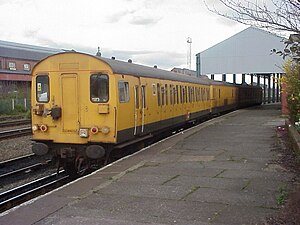British Rail reserved the TOPS Class 97 designation for departmental locomotives, which were used for special or engineering duties. They were therefore of several different classes, lumped together for numbering purposes. Some locomotives were converted from redundant engines, whilst others were purpose built. In 2008, Network Rail once again used Class 97 for signalling test locomotives.

The British Rail Class 104 diesel multiple units were built by Birmingham Railway Carriage and Wagon Company from 1957 to 1959.
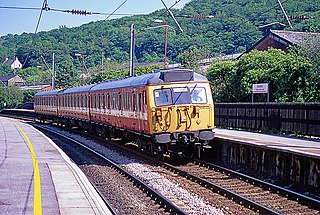
The British Rail Class 308 alternating current (AC) electric multiple units (EMU) were built by British Railways' Holgate Road carriage works in three batches between 1959 and 1961. They were initially classified as AM8 units before the introduction of TOPS.
The British Rail Class 951 was reserved for former diesel-electric multiple units converted for departmental use. Units were converted for various tasks, including application of sandite, de-icing duties, and use as tractor units to tow other trains. This classification is now obsolete, as all units have either been withdrawn, or renumbered into the Class 930 range.
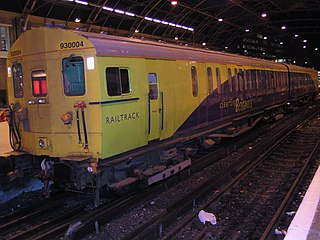
The British Rail Class 930 was reserved for former Southern Region electrical multiple units and diesel-electric multiple units converted for departmental use. Originally the series was reserved for de-icing and, later, sandite units. In recent years, however, other types have also been given numbers in this series. Electric and diesel units are dealt with separately
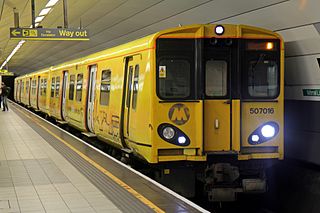
The British Rail Class 507 is a type of electric multiple-unit (EMU) passenger train built by British Rail Engineering Limited at Holgate Road carriage works in two batches from 1978 to 1980. They were the second variety of British Rail's standard 1972 design for suburban EMUs derived from PEP stock, which eventually encompassed 755 vehicles and five Classes. The 507s were the first variant to be 750 V DC third rail only. They have worked on the Merseyrail network from new, and continue to do so, having been refurbished by Alstom's Eastleigh Works. The Class 507 unit is now 43 years old, making them among the oldest units still in service on the UK mainland rail network, after the Class 313 and Class 508.

The British Rail Class 508 electric multiple-unit (EMU) passenger trains were built by British Rail Engineering Limited, at Holgate Road carriage works in 1979–80. They were the fourth variant of BR's standard 1972 design for suburban EMUs, eventually encompassing 755 vehicles and five classes (313/314/315/507/508). They have mostly worked on the Merseyrail network since 1983, and continue to do so, now refurbished by Alstom's Eastleigh Works. The Class 508 unit is now 42 years old, making them among the second oldest units still in service on the UK mainland rail network, after the Class 313.

West Kirby railway station is situated in the town of West Kirby, Wirral, England. The station is located at the end of one of the branches of the Wirral Line, part of the Merseyrail network, and is the westernmost terminal on the Wirral Line. There is a central island platform between two terminus tracks, and two parallel sidings for out-of-use electric trains. The beach can be reached easily from the station.
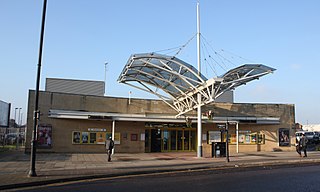
Conway Park railway station is situated in the town centre of Birkenhead, Wirral, England. It lies on the Wirral Line of the Merseyrail network.
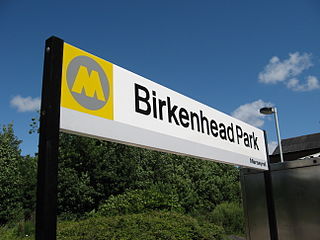
Birkenhead Park railway station is a two-platform through station situated in Birkenhead, Wirral, England. It lies on the Wirral Line 3 1⁄2 miles (5.6 km) west of Liverpool Lime Street on the Merseyrail network.

Birkenhead North railway station is situated in Birkenhead, Wirral, England. The station is situated on the Wirral Line of the Merseyrail network, close to the junction of the New Brighton and West Kirby branches. Birkenhead North TMD, situated just to the west of the station, is the main Traction Maintenance Depot for the Merseyrail fleet.

British Rail Class 503 trains were 65 mph (105 km/h) electric multiple units. They were introduced in two batches. The first were in 1938, by the London, Midland and Scottish Railway (LMS) with a further batch in 1956 by the then nationalised British Railways (BR). When introduced by the LMS, they were officially known as Class AM3. They were designed for, and operated on, the Wirral & Mersey lines from Liverpool to West Kirby, New Brighton, and Rock Ferry. There were few places on their network of closely spaced stations to attain their maximum speed, except for the open section between Moreton and Meols. All but one set were withdrawn and scrapped by 1985. The final set was used on special Merseyrail services until 1988, and this preserved set was kept at the Electric Railway Museum near Coventry until moved to the Locomotive Storage Ltd warehouse at Margate.

The British Rail Class 502 was a type of electric multiple unit originally built by the London Midland and Scottish Railway at its Derby Works. Introduced in 1940 and withdrawn by 1980, they spent the whole of their working lives on the electrified railway lines north of Liverpool.
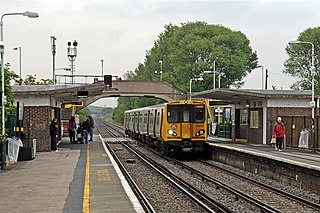
Leasowe railway station is situated near the village of Leasowe, Wirral, England. It lies on the West Kirby branch of the Wirral Line, part of the Merseyrail network.
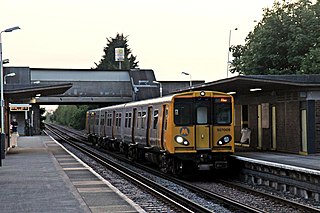
Moreton railway station is situated in Moreton, Wirral, England. The station is on the West Kirby branch of the Wirral Line, which is part of the Merseyrail network.
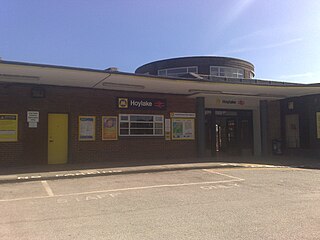
Hoylake railway station serves the town of Hoylake, Wirral, England. It lies on the West Kirby branch of the Wirral Line, part of the Merseyrail network. The station also offers free car parking facilities at all times.

Birkenhead North TMD is a traction maintenance depot, which is owned by Network Rail and located opposite Birkenhead North railway station, currently responsible for servicing and stabling Merseyrail's fleet of Class 507 and 508 electric multiple units.
Hall Road TMD was a railway Traction Maintenance Depot situated adjacent to Hall Road railway station, Merseyside, England. The depot was a facility for storage and servicing of Merseyrail multiple units and rolling stock. It had two shed roads and four additional siding tracks; each road had capacity for three Class 507 or Class 508 electric multiple unit (EMU) sets . The depot code was HR.
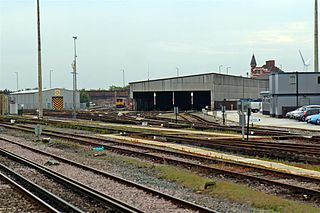
Kirkdale TMD is a traction maintenance depot located beside Kirkdale railway station in north Liverpool, England. The depot is the largest on the Merseyrail network; it is located on the Northern Line and is used primarily for stabling units, heavy maintenance and cleaning units both internally and externally.
